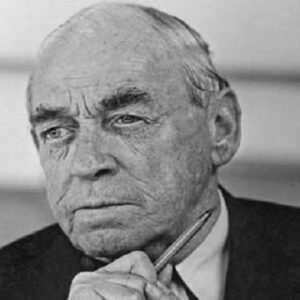Alvar Aalto was a painter, sculptor, and architect from Finland. He is regarded as a significant proponent of midcentury modernism as well as one of the great planners. Furniture, textiles, painting, sculpting, landscape, urban planning, glassware, and jewelry were all part of his fifty-year career. He was the most famous architect in Finland. His prominence stemmed from his humanistic approach to modernism, which included a blend of natural resources, self-expression, and forward movement. His major goal was to create a complete work of art. Aalto did not just design buildings; he also thought about the inside aspects like light fixtures, glassware schemes, and furniture. By relying on the foundation of performance and man’s relationship with organic forms, he rebuilt architecture and the furniture of public facilities, using natural settings as a starting point for ideas. His alternative technique is credited as contributing to the machine-age-driven alienation, visual dullness, and structural monotony of international style throughout the 1950s. As a result, he is known as the “Father of Modernism” among Scandinavian societies.
Childhood and Adolescence
Hugo Alvar Henrik Aalto was born on February 3, 1898, in the little village of Kuortane, Finland. He was the first of Johan Henrik Aalto’s three children born to Selma (Selly) Mathilda Hackestedt, a surveyor.
When Alvar was five years old, his mother Selma died. His father Johan remarried and moved his family to Jyvaskyla, where Aalto went to school and spent his summers surveying with his father.
He relocated to Helsinki after graduating from the Jyvaskyla Lyceum in 1916. He went on to obtain great grades in architecture at Finland’s only architectural school (now the Helsinki University of Technology).
After the Russian Revolution, Finland was the first country to declare independence from Russia. During the Civil War that followed, Alto served in the Finnish National Militia until 1918.
He was a qualified architect with a graduate degree by 1921, and he opened an office in Jyvaskyla two years later. Aino Marsio, his assistant and fellow architect, was employed and married. Their honeymoon in Italy left an indelible mark on his Nordic knowledge and inventiveness, which he carried with him throughout his career.
Alvar Aalto’s Career
While still a student, Aalto began working. He began as an apprentice to Armas Lingren, a Finnish architect, educator, and painter. Under Carolus Lindberg, he also designed buildings for the ‘Tivoli’ region for the 1920 National Fair.
He worked on the design of the Congress Hall at the 1923 Goteborg World Fair alongside A. Bjerke from 1922 to 1923. For the Tampere Industrial Fair, he designed a number of structures.
After Aalto won first place for the ‘Southwestern Finland Agricultural Cooperative Building,’ he and his wife, Aino Marsio, moved to Turku in 1927. He then went on to create the ‘Paimio Sanatorium.’
He established his architectural firm, ‘Artek,’ in 1933, and worked on multiple large international contracts through it. He worked on structures for multiple World Fairs and several masterpieces around the world for the next four decades.
His company, ‘Artek,’ marketed furniture and other imported goods in addition to architect services. He was also the first furniture designer to use wood to implement the cantilever principle in chair designs.
His organic blending of man, architecture, and nature took shape in 1938. As a result, he designed Noormarkku’s most distinguished ‘Villa Mairea.’
Elsa-Kaisa (Elissa) Mankiniemi, his second wife and also a coworker, assisted in the construction of the ‘Muuratsalo Experimental House’ as their vacation residence.
Through the early 1970s, he was still working. Following his death, his office continued to complete his unfinished works under the direction of his widow Elissa. His office continues to provide Aalto building restoration services.
Alvar’s Major Projects
His career was launched by the ‘Southwestern Finland Agricultural Cooperative Building,’ which won him his first award.
The Paimio Sanatorium is a former tuberculosis sanatorium that was completed in 1932. This structure elevated Aalto to the role of heroic functionalism master.
Achievements and Awards
The Royal Institute of British Architects awarded him the Royal Gold Medal.
His contributions were also recognized by the United States. The American Institute of Architects awarded him the Gold Medal in 1963.
Personal History and Legacy
In 1924, Alvar Aalto married Aina. They had two children together: Hamikar Alanen, a son, and Johanna “Hanni” Alanen, a daughter. She died of cancer in 1949.
In 1952, he married Elissa, and the couple remained together until his death in 1976.
He died in Helsinki, Finland, on May 11, 1976.
His most recent structure, the Jyvaskyla Art Museum, was named after him. The Alvar Aalto Museum, which specializes in architecture and design, is now known as such.
“The essential core of architecture consists of a variety and evolution suggestive of natural biological life,” he is quoted as saying. This is the only authentic architectural style.”
Estimated Net worth
Alvar is one of the wealthiest architects and one of the most well-known. Alvar Aalto’s net worth is estimated to be $1.5 million, according to Wikipedia, Forbes, and Business Insider.
Trivia
At the World Fair in New York, Frank Lloyd Wright called Aalto’s design for the Finnish Pavilion a “piece of brilliance.”
On the final series of the 50 Finnish mark banknote, his picture was printed. This happened before the Euro was adopted.


